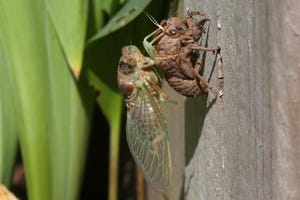Don’t Panic if Your Dog Eats a Cicada. Here’s What to Know

2024’s cicada emergence is starting very soon. Here’s what you need to know about keeping your pets protected.

My sweet dog is addicted to eating cicadas. Every year, for the five years she’s graced this planet, my dog has scarfed down all of the cicadas that emerge all summer long, only to yack them up (dead and alive, to the horror of my family) in my living room. Due to her proclivity, she isn’t permitted to go outside during cicada season without human supervision.
For the longest time, I thought this was simply a bizarre trait unique to my pup, but with a massive emergence of cicadas on the horizon, I’ve learned that a penchant for snacking on cicadas is pretty common for dogs.

I know firsthand how scary it can be the first time your dog eats a cicada — and if your pet happens to have a taste for an emerging brood, you may be worried about what could happen if they consumed too many.
Even though I’m pretty experienced with what to do when my dog eats cicadas, there’s always more I can learn to better take care of my dog. I spoke to two experts to find out everything you need to know about dogs eating cicadas. Read on to find out what you need to know about keeping your pet healthy this summer.
For more, here’s everything we know about Brood XIX and Brood XIII and 13 essentials for new dog owners.
2024’s double cicada emergence
This year’s emergence is set to be one of the most massive of cicadas that the US have seen in recent years. This is because two broods of cicadas will be emerging concurrently this spring. Brood XIX, also known as the Great Southern Brood, and Brood XIII, the Northern Illinois Brood will be emerging at the same time in May of this year.
Now, you don’t need to worry about double emergences becoming a regular occurrence. The last time a double emergence like this happened was back in 1803. The two broods that will be emerging this spring are Brood XIX, also known as the Great Southern Brood, and Brood XIII, the Northern Illinois Brood.
The Great Southern Brood emerges every 13 years and will begin to emerge in May and last until mid-June. The Northern Illinois Brood that is emerging is on a 17 year cycle and will also begin to emerge in May.
This means that from May to mid-June, cicadas will be taking over a whopping 17 states. If you live in Alabama, Arkansas, Georgia, Illinois, Indiana, Iowa, Kentucky, Louisiana, Michigan, Mississippi, Missouri, North Carolina, Oklahoma, South Carolina, Tennessee, Virginia and Wisconsin — you’ll be in for a summer full of cicadas.
So… are cicadas dangerous for dogs to eat?
No, cicadas are not venomous or poisonous, nor do they bite or sting. These seasonal pests are simply loud and annoying. There’s nothing you really need to worry about when it comes to you or your pets’ safety.
However, that doesn’t mean that you should let your dogs go wild eating cicadas each summer. According to American Kennel Club veterinarian Jerry Klein, you really need to fret only if your pet begins acting strange. “The shells can cause, potentially, some gastroenteritis” and, “in a worst-case scenario … could potentially be a blockage.”
Gregory Lawson, from NC State’s College of Veterinary Medicine, recommends considering a vet trip “if the dog seems depressed, like is unusually quiet, less responsive than normal” or if the dog is salivating at an extreme level.
In my experience, I have never had to take my dog to the vet, even after she’s eaten multiple cicadas. She has typically thrown up and had a bit of a sensitive stomach for a couple of days after she’s really gone to town on cicadas, but she has never exhibited any of the symptoms that Klein and Lawson mentioned.
Klein recommends observing your pet for any abnormal behavior, particularly if your pet is repeatedly vomiting and is unable to hold any water down, and recommends calling your veterinarian if you have any questions or concerns.
For more, here’s the best dog toys (according to dogs) and our picks for the best robot vacuums.



